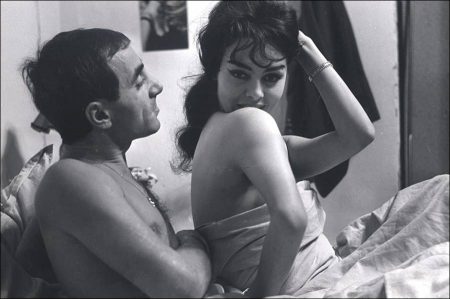Shoot the Piano Player movie storyline. While playing piano in a bar, the pianist Charlie Kohler is approached by his crook brother Chico Saroyan, who has been chased by two gangsters. Charlie helps him to escape, but he upsets the two criminals, and they watch Charlie and the waitress Lena, who is in love with him. The shy Charlie tells his past to Lena, when he was the former famous pianist Edouard Saroyan, and he quit his successful career after the suicide of his wife, waitress Thérèse Saroyan. When his brother Fido Saroyan, who was raised by Charlie, is kidnapped by the gangsters, Charlie has to take an attitude with tragic consequences.
Shoot the Piano Player (French: Tirez sur le Pianiste; UK title: Shoot the Pianist) is a 1960 French New Wave crime drama film directed by François Truffaut and starring Charles Aznavour as the titular pianist. It is based on the novel Down There by David Goodis.
Filming Style and Concept
The film’s script changed constantly during shooting. Truffaut said that “In Shoot the Piano Player I wanted to break with the linear narrative and make a film where all the scenes would please me. I shot without any criteria.”
Truffaut’s stylized and self-reflexive melodrama employs the hallmarks of French New Wave cinema: extended voice-overs, out-of-sequence shots, and sudden jump cuts. The film’s cinematography by Raoul Coutard was often grainy and kinetic, reflecting the emotional state of the characters, such as the scene in which Charlie hesitates before ringing a doorbell.
Among the film references in Shoot the Piano Player are nods to Hollywood B movies from the 1940s, the techniques of using an iris from silent films, Charlie being named after Charlie Chaplin and having three brothers (including one named Chico) as a reference to the Marx Brothers, and the film’s structure and flashbacks being similar to the structure of Citizen Kane.
Truffaut later stated that “In spite of the burlesque idea to certain scenes, it’s never a parody (because I detest parody, except when it begins to rival the beauty of what it is parodying). For me its something very precise that I would call a respectful pastiche of the Hollywood B films from which I learned so much.” This was also Truffaut’s first film to include a murder, which would become a plot point in many of his films and was influenced by Truffaut’s admiration of Alfred Hitchcock.
Truffaut stated that the theme of the film is “love and the relations between men and women” and later claimed that “the idea behind Le Pianiste was to make a film without a subject, to express all I wanted to say about glory, success, downfall, failure, women and love by means of a detective story. It’s a grab bag.” Like The 400 Blows and Jules and Jim, Shoot the Piano Player was shot in Cinemascope, which Truffaut described as being like an aquarium which allows the actors to move around the frame more naturally.
Shoot the Piano Player (1960)
Directed by: François Truffaut
Starring: Charles Aznavour, Marie Dubois, Nicole Berger, Michèle Mercier, Serge Davri, Claude Mansard, Richard Kanayan, Albert Rémy as Chico, Jean-Jacques Aslanian, Daniel Boulanger
Screenplay by: François Truffaut, Marcel Moussy
Production Design by: Jacques Mély
Cinematography by: Raoul Coutard
Film Editing by: Claudine Bouché, Cécile Decugis
Makeup Department: Jacqueline Pipard
Music by: Georges Delerue
MPAA Rating: None.
Distributed by: Les Films du Carrosse
Release Date: November 25, 1960 (France)
Views: 218

